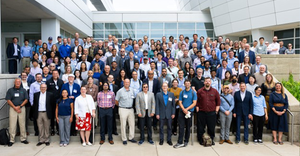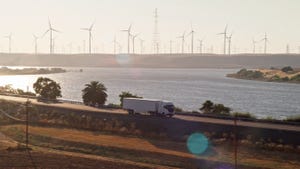10 Takeaways from Day Two at WasteExpo 2015
WasteExpo’s second day featured the opening of the exhibit hall. More than 500 companies have booths at this year’s show. The conference’s education sessions continued, including a super session covering the important issue of how distracted driving poses a risk for the industry. In addition, the NWRA held its annual awards breakfast and honored 23 individuals, including four Hall of Famers and nine Drivers of the Year.
Here are some key takeaways from the second day of WasteExpo.
At the National Waste & Recycling Association (NWRA) annual awards breakfast at WasteExpo, President and CEO Sharon Kneiss provided a State of the Association. The NWRA has ramped up its efforts on advocacy issues, led by its drive to pass Slow Down to Get Around laws. To date nine states have passed or amended such driver safety laws, and several others are considering it. The NWRA has stressed education about recycling–its cost and ways to make it feasible. And the association has added 70 new member companies.
Bruce Ranck, long-time industry executive and CEO of Republic Services Inc. predecessor Browniing-Ferris International (BFI), made an eloquent acceptance speech with his induction into the NWRA Hall of Fame. He noted BFI’s many achievements during his tenure, including safety and customer retention. But he gave the credit to the thousands of BFI employees that made it happen. In describing the culture of BFI he said, “I would highlight respect. And you can’t fake respect.”
Zero Waste Energy’s Jeff Draper talked about some of his company’s approaches to anaerobic digestion (AD) and some of the challenges in a session on AD technologies. There are two different processing approaches: an integrated waste management model and a source-separated approach. Contamination is one of the big challenges with AD. The Zero Waste system can handle 5-35 percent contamination. Glass is a particular challenge in any composting application.
Threes are wild for Rumpke. Three employees took home Driver of the Year honors as part of NWRA’s annual awards program. It’s third consecutive year that Rumpke has taken three prizes in the competition.
Communities struggle to enact food waste collection programs and face the challenges of cost, education and contamination, said David Schneider, vice president of business development for Anaergia, at the AD session. The company’s latest generation Orex organics extrusion press can handle any level of contamination, he claims. In a recent test, the device got 70-95 percent organics recovery from the municipal solid waste (MSW) stream when the organics is source-separated. This compares to 30-35 percent for single-family residential waste streams.
The Distracted Driver Safety Super Session provided a lot of scary numbers. Jerry Peters of Rumpke Consolidated Companies told the audience that 18 percent of all vehicle-related deaths are from distracted driving, for a total of 3,154 deaths in the most recent annual data available. Five seconds of distracted driving can cover the length of a football field. Larry Stone of Waste Pro USA pointed out that 58,000 military deaths for the United States in Vietnam during a 10-year period caused seismic unrest in the country, but 32,000 annual vehicle deaths here don’t nearly generate that kind of concern. He stressed a formula of how long it takes to stop a vehicle–1.44 times vehicle speed represents how many feet per second the vehicle is covering. Educate drivers about this formula, he says; they’ll realize the math involved with stopping to avoid accidents–and how being distracted destroys that safety measure. Finally, Shawn Mandel of Waste Connections Inc. said that Americans send 153.5 billion text messages each month. And at any one time, 660,000 U.S. drivers are using some type of hand-held device.
Del Lisk of Lytx Inc. pointed out that distracted driving involves many other behaviors besides using smartphones. There’s driving too close. From his surfing days, he recalls putting on a wet suit in the car. The ability to monitor drivers’ behavior and give them feedback is key. Eric Conn, an attorney with Conn Maciel Carey PLLC, works on compliance with the Occupational Safety & Health Administration (OSHA). But the real legal concern is with states, because they make laws on driving. Currently, 46 states have some kind of ban on texting while driving. Fifteen states require hands-free cell phone use. But OSHA will get involved if phone use is part of the work expectations of the employee. OSHA can deem that incompatible with providing a hazard-free work environment.
The increased demand for organics recycling is affecting waste truck design. As one example, McNeilus Truck & Manufacturing Inc. offers a split-body back loader with one portion optimized for organics collection. The two gates function independently. The side optimized for organics collection includes a full-height tailgate seal, a double seal on sweep panels and a load-edge extension all designed to contain the excess liquids inherent in organics collection. The truck’s leachate tank has also been fitted with four-inch lines rather than two-inch lines to reduce clogging from solids.
CP Group began installation of its equipment at Republic Services’ new Las Vegas MRF, which will be the largest single-stream facility in the nation when it’s completed. The facility will feature two 35-ton-per-hour systems side-by-side. So at peak capacity it will be able to process 70 tons per hour. Construction of the facility is the product of coordinated work between CP, Republic and Cambridge Construction.
Composter Green Good Composting went the extra mile in exhibiting its technology. It is conducting live composting at its booth, including composting some of the food waste being generated during the course of WasteExpo 2015.
About the Authors
You May Also Like




